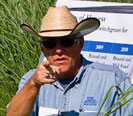
Vanessa Corriher-Olson
Forage Specialist
Texas A&M AgriLife Extension
Good available forage and lower feed prices are helping offset prices in the calf market. Atypical August rains have range and pastures in good shape, and Texas produced record corn and sorghum crops, which could impact the market as well. August rains also brought on fall armyworm populations that severely damaged many hay meadows and pastures throughout Texas.
Temperatures have been above average during September, which has allowed for continual growth of warm-season perennials. Many have planted or are beginning to plant winter pastures, including small grains, annual ryegrass, and/or cool-season annual legumes.
Parts of northeast Texas are abnormally dry and all are hopeful for some fall moisture. Abundant hay may have many feeling overly confident in their winter-feeding plan. Unfortunately, some of that hay has low nutritive value from being harvested at late maturity. Spring rainfalls delayed most first and second cuttings. When harvesting finally began, forage was abundant but quality was poor.
Fingers are crossed for successfully established winter pastures and abundant rainfall as we move into winter.

Ray Smith
Extension Forage Specialist
University of Kentucky

Tom Keene
Extension Hay Specialist
University of Kentucky
Weather conditions have been cyclical in Kentucky in 2016. Early to midsummer excess moisture allowed excellent forage production, but limited good haymaking days. Overall, forage quality will be average to below average, especially for first-cutting grass hay. Alfalfa and grass hay quality will be good for later summer harvests. On-farm hay inventories should be adequate, unless winter conditions are severe. It will be important for cattle producers to test hay quality when feeding or when buying hay this winter.
Rainfall since early August has been well below average across the state. This provided excellent hay drying conditions, but resulted in limited regrowth both in hayfields and pastures. Pastures in early October are in only fair condition due to dry weather. The volume of stockpiled permanent pasture will be low going into winter.
Most fall forage plantings have emerged, but growth is limited since subsoil moisture is virtually nonexistent. In some regions, seed planted in early September is still in the ground. Kentucky producers with new stands will need rainfall soon and a late fall to allow sufficient plant development for winter survival.

Jessica Williamson
Extension Forage Specialist
Penn State University
Pennsylvania has been blessed with drought alleviation over the past month with moderate temperatures, allowing for accumulated forage growth in cool-season pastures and hayfields. Pastures are still being grazed, and warm-season annuals are on their final grazing or harvesting.
With the recent rainfall and temperatures in the low- to mid-70s, pastures are looking good going into winter. They’re coming out of a severe summer slump that was prevalent across most of the state. The final cutting of alfalfa has been removed this past week in most of the state, while grass hay is still being harvested and wrapped for haylage.
Corn silage has for the most part been harvested in the majority of the state; the exception being some later maturing varieties and in portions of the northern tier of Pennsylvania.
Some cover crops that were planted immediately after silage removal are germinating and growing under the ideal weather conditions we are having this fall, while others are just being planted. Regardless, thousands of acres in Pennsylvania will have a winter cover this year, with the majority to be removed as silage in the spring.

